CCGS Sir John Franklin
Canadian Coast Guard
Overview
The CCGS Sir John Franklin is the first vessel produced in the new Canada Coast Guard class of offshore fisheries research vessels. It was ordered in 2011 and built by Seaspan Shipyards in Vancouver BC and received by the Pacific Fleet in 2019. The Franklin is the only offshore fisheries research vessel in the Pacific Region and is capable of performing full oceanographic sampling. For this reason, it is used to conduct all trawl research surveys conducted by Fisheries and Oceans Canada in the Pacific Region, including bottom trawl for groundfish and shrimp surveys, midwater trawl for hake surveys and pelagic trawl for juvenile salmon surveys. The CCGS Sir John Franklin will be the only Coast Guard ship taking part in the 2022 Pan-Pacific Winter High Seas Expedition.

UPDATES FROM THE SHIP
Click on photo gallery to enlarge images!
We held a successful media event at the Coast Guard base in Victoria, British Columbia to celebrate the return of the CCGS Sir John Franklin.
Dignitaries from Fisheries and Oceans Canada and the Province of British Columbia and partners from the Pacific Salmon Foundation, the University of British Columbia, and the University of Victoria joined chief Canadian scientist on the CCGS Sir John Franklin and Canadian expedition country lead Dr. Jackie King, Canadian scientists Nicholas Ens and Cynthia Wright, and chief expedition scientist Dr. Evgeny Pakhomov, to celebrate this successful expedition and speak to its scientific accomplishments.
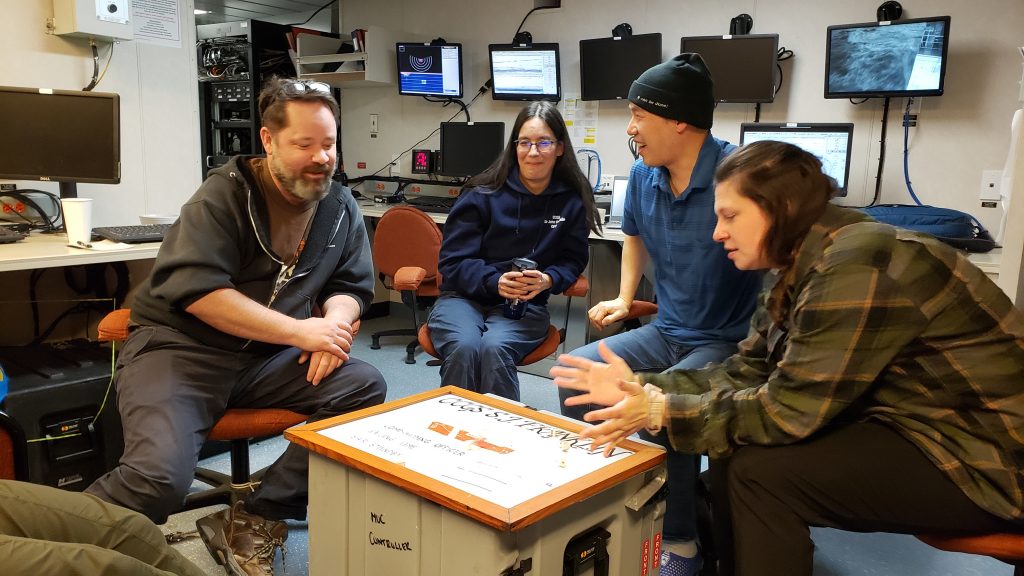
Another day motoring back east as we try to avoid a severe storm system to the west. Waves were high enough to come over our sideboards and drench our nets on the deck, so fishing was a non-option. The sun was beautiful though! We all worked on side-projects and emails that have been building up over the survey. This evening we had some rousing games of Yahtzee and nuscht to finish the day. Hopefully tomorrow we will reach 132W where, if the weather clears for a moment, we could do a bonus couple of stations.
What do scientists do near the end of a long survey when the wind and waves prevent them from fishing? Some organization of all the samples collected over the past 4 weeks, and processing oxygen samples that can’t wait for waves to calm down. The final round of the 2nd leg crib tournament, featuring John from the Coast Guard narrowly defeating Daniel from the science team with some incredible pegging! And to finish off the day, why not a little Who’s Line is it Anyway in the control lab? We are still hoping that the weather will calm down tomorrow for one last opportunity to fish before we need to motor back to Port Hardy.
As we are nearing the end of our survey, and a strong weather system is likely to move in over the coming days, we have been hitting stations as fast as possible over the past couple days. Oceanography takes us around 2 hours, and fishing another 1.5 hours, followed by 5 hours transit with each southward run. This leaves limited opportunity for sleep between stations, but means we may be able to sample the last of the remaining stations over the next couple days. Fishing-wise today was another sockeye day, we caught 5 early this morning and another one in the afternoon. Next station should be at 0600 at 53N 144.
😉
The sound of the trawl winch was conspicuously absent today as the swell and wind built up, preventing us from fishing all day. We managed to run oceanography (bongo net, tucker trawl, and rosette) before the winds stopped us, but the rest of the day involved watching pre-downloaded movies and waiting for any drop in the winds. Hopefully by tomorrow morning we will be able to put nets in the water. We are along the 57 N line of latitude and would love to sample this along our most northern station.
Kept moving north today, knocking off stations at 55 and 56 degrees north along the 141 west line of longitude. Caught one sockeye at 56 N and plenty of jellies and stickleback at both stations. Now proceeding to 57 north which we should get to in the wee hours of the morning. Hoping to get as many stations done as possible before a heavy wind and swell system moves in over the next few days!
Got to our next station at 54N 141W at 3pm this afternoon. To our great surprise, it came up as a basketful of threespine stickleback! These small, well-armored fish are highly studied for their ability to adapt to a wide array of habitats, including many lakes and inshore environments. These were shockingly far out for our expectations, so we froze many of them for later analysis.
Cindy in the CTD room shows Cindy reviewing the event log from the CTD control room where the rosette containing the CTD sensors and niskin bottles is controlled, and where she will record each event (net in the water, rosette, bongo etc.) in the log sheet. Hilari by the rosette shows Hilari watching the zooplankton tows from inside the rosette room. Tucker haul shows the three cod-ends containing all the zooplankton caught in the tucker trawl from 400m deep to the surface.
We all slept in today after last night’s late station, and arrived at our next station at 55N 138W at 3PM today. All our sampling went very well. We caught many krill and myctophids in the deep tucker trawl net, and a single chum salmon in the surface trawl amongst many jellyfish. Next station is at midnight tonight, so we are all taking a quick snooze before then.
More salmon caught in our second set of the day (or rather at 3AM on the 11th)! 2 chum and 3 sockeye caught and processed by our team! We also found a rare daggertooth in the net, a small but vicious fish with huge sharp teeth relative to its size.

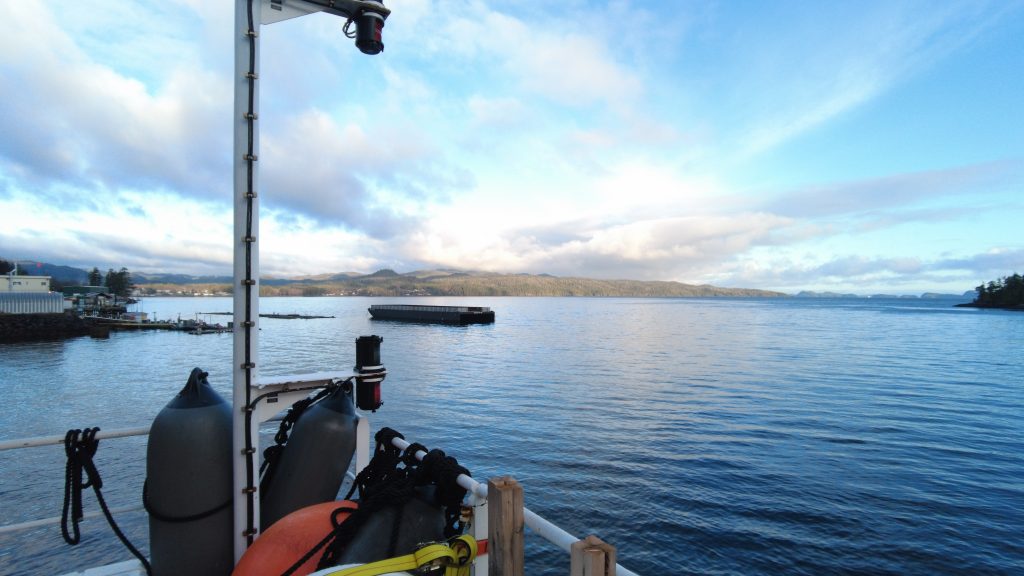
Arrived in Port Hardy today at 0730 for a needed fuel up, resupply, and science crew change! It felt great to see land again and to be semi-stationary after some time at sea. We all took some time to call loved ones (miss you Gill!) while in precious cell coverage. The bus with the crew for leg 2 came around noon, and after packing up all their things we said farewell to (most of) the science team from leg 1, who left for the government dock via a tender trip. Myself and Erika will be staying on board for the second leg to ensure continuity in our sampling procedures. The new crew were then tendered on board and shown the ropes by Oliver. We briefly discussed sampling protocols but will further practise en route to our next station at 53 degrees north 135 degrees west. We should arrive there on Thursday!
Given we are at the end of our first leg, we wanted to honor the coast guard crews who are making this science possible! Thanks to the bridge crew for overseeing everything going on in the Franklin and for keeping us ahead at 1.4 knots for Tucker trawls. Thanks to the engineering crew for keeping this ship afloat and running 20 ft of AVI cable when we need to view a computer on a screen a floor down. Thanks to the deck crews for handling all the winches, nets, hoses, and requests that we make of them. Thanks especially to the supply team for ensuring we are all very well fed and well stocked from linens to resupplies at port. Without all these people we would have no hope of coming out here and examining salmon as we have!
Bridge Crew (R to L):
2nd Officer Oliver Ateah; Commanding Officer Zbigniew Chmara; Chief Officer Kevin McKechnie
Engineering Crew (Back row then front row, R to L):
Chief Engineer Andrew McIlrath; Senior Engineer Tom Hildebrandt; 3rd Engineer Alfred (AJ) Crocker; Electrical Officer John Motuz; 2nd Engineer Scott Babiuk; Electrical Officer Kazlen Kotilla; ERA (Oiler) Arron McCarthy
Evening Deck Crew (R to L):
Seaman Chris Clark; Boatswain Darcey Nichol; Leading Seaman David Greaves; Fishing Master Keith Fry; Leading Seaman Dylan Harrison; Leading Seaman Nick Van Der Sande; Leading Seaman Elijah Best
Morning Deck Crew (Back row then front row, R to L):
Boatswain Darcey Nichol; Fishing Master Keith Fry; Leading Seaman Neil King; Leading Seaman Ryan McLean; Leading Seaman John Lincoln; Seaman Kaylum King; Leading Seaman Arioney Gomes-Firmino
Supply Crew (Back row then front row, R to L):
Logistics Officer Miranda Russell; Steward Jonathan Sprague; Chief Cook Constantino (Tino) Pereira; Steward Eric Martinen, 2nd Cook Christine Freidman
The krill and myctophid sort video is a hyperlapse showing what happens when we get a mix of smaller organisms in the surface trawl. After an overall weighing, the mix is split into a manageable portion and sorted by species (here by Rick, Anna, Tyler, and Jackie). In this case they are separating squid, blue lanternfish, northern lanternfish, and krill.
The weighing and sorting myctophids video shows Rick and Tyler taking the lengths and weights of some of the 100 lanternfish we sample at each station we catch them at. Tyler calls out weights (usually 1 gram as the fish are too small for our best scales at sea) and measures each fish using a magnetic fish length measuring board, while Rick enters the weights into the computer. These measurements help us understand what the size distributions of lanternfish are, and can be used to identify generations of lanternfish.
Finished two stations at 138 degrees W today, one at 53N and one at 52N. Sampling went smooth overall, and we caught some more sockeye and chum at the stations! During our evening tow the salmon had clearly just eaten, their stomachs were jam packed with krill, jellies, and pteropods! Good to see that they are eating their fill.
The photo of Anna is her identifying and separating large zooplankton by group so that she can examine the energy content of the zooplankton later. This will allow her and the Hunt lab to calculate the flow of energy up the food web from phytoplankton to zooplankton to larger nekton like squid and up to salmon!
The water sampling video is a hyperlapse of what happens when the rosette gets loaded on board. The deck crew operate the winches to bring it in, then the science team comes in like vultures to fill many different bottles with water! The case Nic is holding is Christoph Deeg’s eDNA case which filters straight from the niskin bottles. Anna is filling jugs for particulate organic matter chemical analyses. Chelsea and Liam are filling HPLC (high performance liquid chromatography) samples which will be filtered to look at what phytoplankton are present. The brown small bottles that Nic and Chelsea fill are for chlorophyll filtration, also for looking at phytoplankton. The large filters that run into the bottles that Chelsea and Liam use are to prefilter water that is used to look at metal binding ligands in the water. You’ll notice that we rinse off all the bottles several times with the seawater to ensure our samples aren’t contaminated. After all the water samples have been collected and brought into the lab, and Nic is finished filtering the eDNA samples, he comes back to the rosette to empty the remaining water and reset all the niskin bottles for the next cast.
Started at station 52-141 at 0700 and caught 7 sockeye and 3 chum to start the day! This afternoon we sampled at station 53-141 and caught 2 sockeye and 2 chum. One of the chum was very emaciated for its length, so we took a look inside to see what the problem was. The stomach contents showed us that she was eating krill and jellies, but hopefully an in depth lab analysis of the liver, gill, blood, and muscle tissues will reveal why this particular salmon was so thin. Lots of large copepods in the plankton tows today. As spring begins a few species of larger copepods will migrate from 400+ m depths to the surface to feed and breed, triggering a huge shift of biomass into the upper water column. It seems we are just in time to witness the start of this shift! Cloudy and foggy morning.
Today started with some whipping 30knt winds and strong swells, so after waiting on station for the weather to calm down our fearless leader Jackie decided it was best that we try our luck further northeast where conditions were better. We then were on course for the intersection of the 51st north parallel and the 141st west line of longitude which we hit at 2000 this evening. Plankton tows yielded plenty of krill and lanternfish – prime salmon prey, and the surface tow showed the salmon were taking advantage of the feast! We caught 25 sockeye salmon which are currently being processed by Erica and Tyler into the night. Beautiful weather!
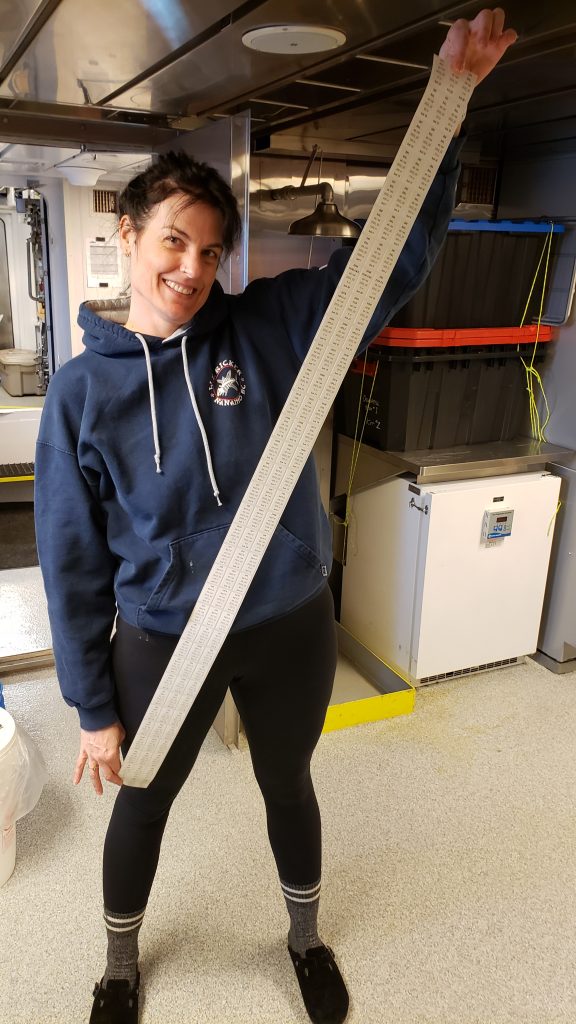

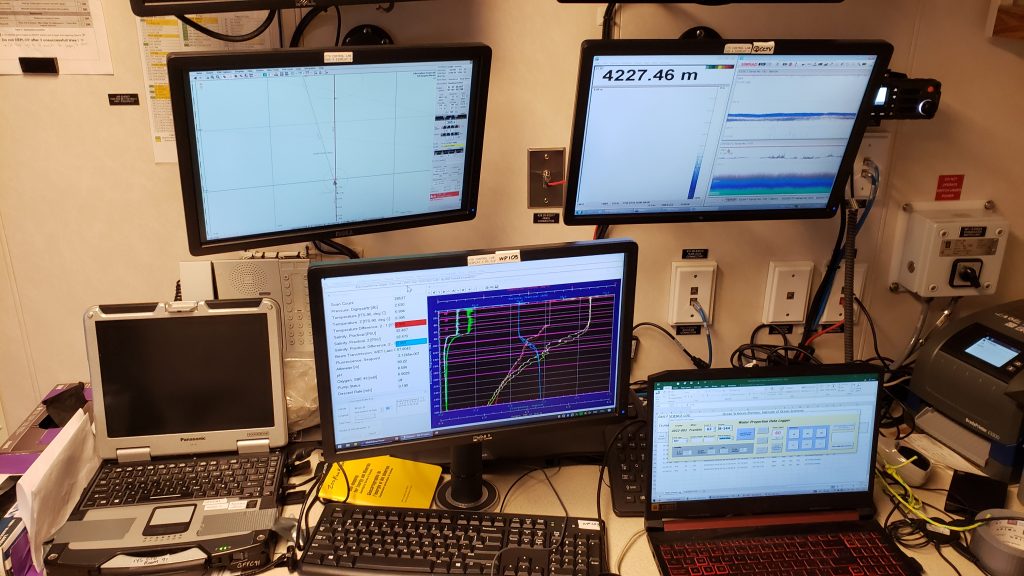
Great start to the day today as the swell was much lower than yesterday, allowing smooth sampling of oceanography and fishing. Few fish in this tow, however, though this is expected when we fish during daylight hours. As our nets only cover surface waters, they likely miss salmon that dive deeper during the daytime to avoid predators. This is why we often see more salmon caught during tows at night! We had a good descent to 2000m for our rosette at our second station today. Unfortunately just after the rosette was on board, the winds and swell picked up, leading us to hold off on fishing until conditions improve.
Finally made it to 144 degrees west, as far west as our ship will go this survey. Beautiful morning as the sun rose under distant rainclouds to give us a sunny first station, an extra station at 46 degrees north which we picked up as we are ahead of schedule. Unfortunately, no salmon caught during the tow, but the Tucker trawl caught a hatchetfish, a very rare sight this far north! Our second station was a ‘deep’ station, where we sent our rosette down to 2000m deep to collect water which will be used to determine what the deep water of the Pacific is like chemically and physically. Just getting the rosette to this depth and back took 2 hours! We had a huge laundry list of samples to collect for analysis back on land. At both our stations today we were to release ARGO floats, however the second float failed to start. Hopefully will see data from the first beamed to satellites in the coming weeks. The second tow of the day yielded only two salmon, but plenty of salmon prey! Krill, squid, and lanternfish of all kinds were abundant and many will be frozen to analyze the nutrition of what our pacific salmon are eating.
Fishing went very smoothly today, and we caught our first sockeye! At both stations today we found sockeye salmon, and in the first set just after dawn we found a myctophid (lanternfish) in the stomach of the sockeye – its breakfast for the day. After our first set the sun peeked through the clouds, making for a lovely break between stations on the bridge. Weather was cloudy with breaks of blue sky and sunshine, swells of 2-3m.
Not much happening today unfortunately, as strong winds and waves knock us about and prevent us from deploying any nets or the rosette. Hopefully by tomorrow conditions improve to allow for us to sample again.
Two more stations down today. The seas picked up with 2-3m swells that were coming over the sides of the ship and into the CTD room while we were deploying! Winds were coming up to 30 knots and blowing white froth from the waves, but thankfully all the sampling went off without a hitch today. We deployed our first ARGO floating sensor array and have confirmed that it is transmitting data! These instruments will automatically sink and float, collecting temperature, salinity, and oxygen data from the water and transmitting them via satellite to monitors all over the globe as part of a worldwide climate data effort. Chief scientist Jackie King and lead oceanographer Chelsea Stanley can be seen listening to the ARGO, waiting for the beep which confirmed it was running. Darcy, Gomez, and Caleb with the Coast guard tossed the ARGO off to sea. We also caught our first chinook salmon today, which is very exciting and got Erica stoked for identifying what it was up to in the open Pacific. The CCGS Sir John Franklin also caught its first Chinook salmon and deployed its first ARGO float. We found notosomus shrimp in the tucker trawl and experienced strong wind and waves.
Ran through the whole gamut of sampling today in perfect weather conditions! Caught some interesting specimens in the Tucker and bongo nets, including a viperfish, clione (pelagic snail), and some sergestid shrimp. The rosette worked well and we were able to get all the water we needed. Caught more salmon in the second station late in the day, some young chum and pink!
Today has been clear and sunny with some swell. Left Victoria this morning at 0730. Went a little ways out and tested the rosette functions. The niskin bottles for water sampling worked perfectly, and after a few adjustments the other sensors on the rosette were in full working order as well. Due to a problem with the winch conducting cable, we were unfortunately unable to use the MOCNESS or multinet systems for sampling zooplankton as these both require a wired connection to the shipboard controller. We have switched to using a Tucker trawl system which operates purely mechanically and so does not need the conducting cable. This worked excellent in a trial run. After these tests the fish lab crew and oceanography crew ensured all the labs were ready and we started off west! Swells grew over the day and into the night, leading some of us (myself included) to feel fairly seasick! With time and medication I’m sure we will be back in the game asap.
We came up to the last station we will do this survey this morning! We managed to fish in between the waves at 51N 132W, in between storm squalls which brought hail and rain, and beautiful sunny sections. Oceanographic sampling went well, though due to the waves the Tucker net cable jumped out of the block. Thanks to quick work by the Coast Guard the issue was resolved painlessly. Unfortunately our final surface trawl yielded nothing but jellies, no salmon to finish the survey.
The Scientific Team
Meet the fascinating team of scientists on board the Canadian research vessel the CCGS Sir John Franklin


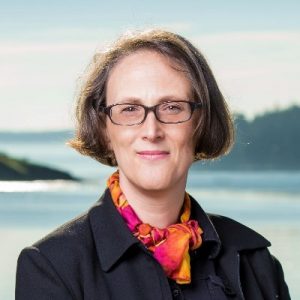 Dr. Jackie King is the Program Head of Basin and Coastal-scale Interactions program with Fisheries and Oceans Canada. Her research investigates linkages between basin-scale processes and coastal-scale ecosystems including climate forcing, large-scale oceanographic processes, and connectivity in large marine ecosystems. She collaborates in integrative pelagic field studies along the continental shelf, with her primary focus on understanding the factors controlling the abundance, distribution, and production of salmon and associated species in marine ecosystems. She is also the lead for the Canadian Pacific Shark Research Program; responsible for all Canadian Pacific elasmobranch research and conservation.
Dr. Jackie King is the Program Head of Basin and Coastal-scale Interactions program with Fisheries and Oceans Canada. Her research investigates linkages between basin-scale processes and coastal-scale ecosystems including climate forcing, large-scale oceanographic processes, and connectivity in large marine ecosystems. She collaborates in integrative pelagic field studies along the continental shelf, with her primary focus on understanding the factors controlling the abundance, distribution, and production of salmon and associated species in marine ecosystems. She is also the lead for the Canadian Pacific Shark Research Program; responsible for all Canadian Pacific elasmobranch research and conservation.
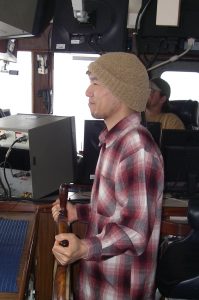 Yeongha (Johan) Jung has been working with the juvenile salmon program in the Regional Ecosystem Effects on Fish & Fisheries Section at the Pacific Biological Station in Nanaimo for 14 years. He has over 36 experience of field research related to High Seas and Strait of Georgia juvenile salmon program including trawl, purse seine and beach seine surveys.
Yeongha (Johan) Jung has been working with the juvenile salmon program in the Regional Ecosystem Effects on Fish & Fisheries Section at the Pacific Biological Station in Nanaimo for 14 years. He has over 36 experience of field research related to High Seas and Strait of Georgia juvenile salmon program including trawl, purse seine and beach seine surveys.
His specialties are identifying all salmon species from fry to adult stage, biological sampling, retrieving, preparing and reading CWT, PIT tag and otoliths. He is also able to sample oceanographic data with Seabird CTD and RBR, collecting water, phytoplankton and zooplankton. He is trained for on board acoustic equipment such as Simrad EK80/SX90 and HiPAP as well.
He is very excited to join the IYS expedition will expand his experience on high seas beyond the station P.
 Cameron Freshwater is a research scientist with Fisheries and Oceans Canada’s Ecosystem Science Division. His work focuses on the intersection between Pacific salmon marine ecology and fisheries management. He is particularly interested in spatio-temporal distributions, drivers of recruitment variability, and management strategy evaluations. He has participated in numerous salmon surveys since 2013 and currently manages a program to estimate adult Chinook salmon abundance, survival, and movement rates in southern BC marine regions.
Cameron Freshwater is a research scientist with Fisheries and Oceans Canada’s Ecosystem Science Division. His work focuses on the intersection between Pacific salmon marine ecology and fisheries management. He is particularly interested in spatio-temporal distributions, drivers of recruitment variability, and management strategy evaluations. He has participated in numerous salmon surveys since 2013 and currently manages a program to estimate adult Chinook salmon abundance, survival, and movement rates in southern BC marine regions.
 Cindy Wright is a biogeochemical oceanographer studying carbon and particulate dynamics in the NE Pacific. She works for the Department of Fisheries and Oceans as an oceanographic technician supporting numerous physical, biogeochemical and fisheries programs. Along with Chelsea Stanley, her main roll will be overseeing sampling for physical oceanographic properties and biogeochemical sampling during the IYS cruise including the zooplankton sampling.
Cindy Wright is a biogeochemical oceanographer studying carbon and particulate dynamics in the NE Pacific. She works for the Department of Fisheries and Oceans as an oceanographic technician supporting numerous physical, biogeochemical and fisheries programs. Along with Chelsea Stanley, her main roll will be overseeing sampling for physical oceanographic properties and biogeochemical sampling during the IYS cruise including the zooplankton sampling.
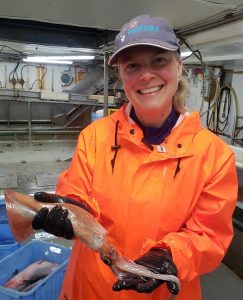 Erika Anderson works as an aquatic biologist at the Pacific Biological Station for Fisheries and Oceans Canada. She completed her doctorate in biology at the University of Victoria and Advanced Diploma in Geographic Information Systems at Vancouver Island University. Her experience leading British Columbia midwater trawl surveys, studying juvenile Pacific Salmon in an ecosystem context, led to her participation in this exciting Pan-Pacific Winter High Seas Expedition. Her recent research has focused on how juvenile Sockeye Salmon energy density varies by stock and relates to early marine hypotheses regarding food, survival and competition. During this scientific expedition, Erika hopes to learn more about Pacific Salmon condition, diet, and stocks in the Gulf of Alaska, and how these findings may be used to ensure Pacific Salmon survival.
Erika Anderson works as an aquatic biologist at the Pacific Biological Station for Fisheries and Oceans Canada. She completed her doctorate in biology at the University of Victoria and Advanced Diploma in Geographic Information Systems at Vancouver Island University. Her experience leading British Columbia midwater trawl surveys, studying juvenile Pacific Salmon in an ecosystem context, led to her participation in this exciting Pan-Pacific Winter High Seas Expedition. Her recent research has focused on how juvenile Sockeye Salmon energy density varies by stock and relates to early marine hypotheses regarding food, survival and competition. During this scientific expedition, Erika hopes to learn more about Pacific Salmon condition, diet, and stocks in the Gulf of Alaska, and how these findings may be used to ensure Pacific Salmon survival.
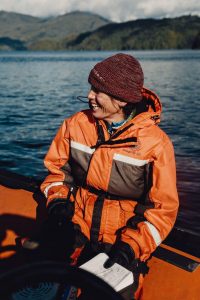 Amy Tabata is a biologist working in the Ecosystems Science division at Fisheries and Oceans Canada. Her current work focuses on the marine migration and ecosystems of juvenile salmon, which includes participating in trawl surveys along the British Columbia coast. She brings that experience, along with a background of working on salmon and other marine species using molecular biology and genetic methods. She is looking forward to participating in the Canadian leg of the Salmon Pan-Pacific Expedition to help add to the story of pacific salmon, and is very interested in how the data from various surveys at different times and places can work together, and how we might be able to use this knowledge to better understand the various factors that impact salmon survival.
Amy Tabata is a biologist working in the Ecosystems Science division at Fisheries and Oceans Canada. Her current work focuses on the marine migration and ecosystems of juvenile salmon, which includes participating in trawl surveys along the British Columbia coast. She brings that experience, along with a background of working on salmon and other marine species using molecular biology and genetic methods. She is looking forward to participating in the Canadian leg of the Salmon Pan-Pacific Expedition to help add to the story of pacific salmon, and is very interested in how the data from various surveys at different times and places can work together, and how we might be able to use this knowledge to better understand the various factors that impact salmon survival.
 Tyler Zubkowski is a Senior Technician with the Department of Fisheries and Oceans out of the Pacific Biological Station in Nanaimo, BC. He has over 20 years of experience working on juvenile and adult salmon in the marine environment. He participates in multiple Ecosystem surveys each year on the Pacific Coast. He is looking forward to being part of a great team on this expedition
Tyler Zubkowski is a Senior Technician with the Department of Fisheries and Oceans out of the Pacific Biological Station in Nanaimo, BC. He has over 20 years of experience working on juvenile and adult salmon in the marine environment. He participates in multiple Ecosystem surveys each year on the Pacific Coast. He is looking forward to being part of a great team on this expedition
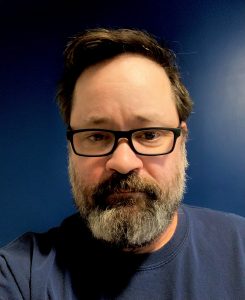 Daniel Williams is currently an aquatic science technician at the Pacific Biological Station in Nanaimo, BC. He has been pursuing diverse experiences in the marine biology world on the Pacific Coast ever since he was old enough to walk a tideline. It became rapidly apparent that he prefers a life at sea so now that is where he goes whenever possible. Daniel is honoured to be participating in the IYSS and looks forward to spending time in the middle of the Pacific Ocean whilst looking at fish and playing in the lab during the less touristed months.
Daniel Williams is currently an aquatic science technician at the Pacific Biological Station in Nanaimo, BC. He has been pursuing diverse experiences in the marine biology world on the Pacific Coast ever since he was old enough to walk a tideline. It became rapidly apparent that he prefers a life at sea so now that is where he goes whenever possible. Daniel is honoured to be participating in the IYSS and looks forward to spending time in the middle of the Pacific Ocean whilst looking at fish and playing in the lab during the less touristed months.
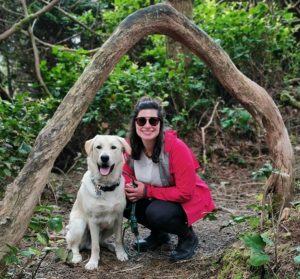 Hilari Dennis-Bohm is an aquatic biologist with Fisheries and Oceans Canada at the Pacific Biological Station in Nanaimo, British Columbia. Her current research focuses on understanding Pacific Herring interactions and linkages with other biological and physical variables in their environment. Hilari organizes the at-sea sampling for the annual Integrated Pelagic Ecosystem survey led by Dr. Jennifer Boldt and Dr. Jackie King. This collaborative survey examines the structure and function of the pelagic ecosystem, primarily focusing on Pacific Herring and juvenile Pacific salmon, off the west coast of Vancouver Island. Hilari’s experience on these surveys and passion for field work led her to participate in the 2022 Gulf of Alaska Expedition. She completed her BSc. in Marine Biology (honours co-op) at Dalhousie University in Nova Scotia, Canada and an MSc. in Marine Mammal Science from University of St. Andrews in Scotland. Her research interests include factors affecting the abundance, distribution, movement, and trophic dynamics of pelagic fish. During this expedition, Hilari hopes to learn more about the condition, energy storage, and distribution of pelagic species and how lower trophic species impact the Gulf of Alaska ecosystem.
Hilari Dennis-Bohm is an aquatic biologist with Fisheries and Oceans Canada at the Pacific Biological Station in Nanaimo, British Columbia. Her current research focuses on understanding Pacific Herring interactions and linkages with other biological and physical variables in their environment. Hilari organizes the at-sea sampling for the annual Integrated Pelagic Ecosystem survey led by Dr. Jennifer Boldt and Dr. Jackie King. This collaborative survey examines the structure and function of the pelagic ecosystem, primarily focusing on Pacific Herring and juvenile Pacific salmon, off the west coast of Vancouver Island. Hilari’s experience on these surveys and passion for field work led her to participate in the 2022 Gulf of Alaska Expedition. She completed her BSc. in Marine Biology (honours co-op) at Dalhousie University in Nova Scotia, Canada and an MSc. in Marine Mammal Science from University of St. Andrews in Scotland. Her research interests include factors affecting the abundance, distribution, movement, and trophic dynamics of pelagic fish. During this expedition, Hilari hopes to learn more about the condition, energy storage, and distribution of pelagic species and how lower trophic species impact the Gulf of Alaska ecosystem.
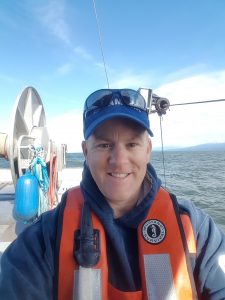 Rick Ferguson is a Senior Technician with the Department of Fisheries and Oceans, working out of the Pacific Biological Station. He has worked on Salmon and Invertebrate programs throughout the Pacific Region for over 20 years and leads or participates in multiple at-sea surveys annually. He is keen to experience the North Pacific in February and to help collect Science that will help better understand the offshore waters in winter
Rick Ferguson is a Senior Technician with the Department of Fisheries and Oceans, working out of the Pacific Biological Station. He has worked on Salmon and Invertebrate programs throughout the Pacific Region for over 20 years and leads or participates in multiple at-sea surveys annually. He is keen to experience the North Pacific in February and to help collect Science that will help better understand the offshore waters in winter
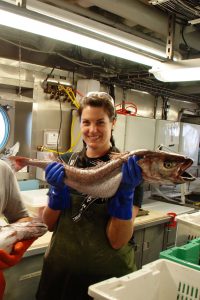
Chelsea is an Aquatic Research Technician with Fisheries and Oceans Canada supporting a wide variety of programs in biological and chemical oceanographic sampling. Her main project focusses on fisheries acoustic research on the distribution of Pacific Hake in the NE Pacific. She has lent her technician skills to a wide array of surveys including those that have taken her to the Arctic and Antarctic, as well as the NE Pacific. She has a keen interest in examining the layers of marine species identified by scientific echosounders using discrete sampling plankton nets, especially in offshore areas around seamounts.
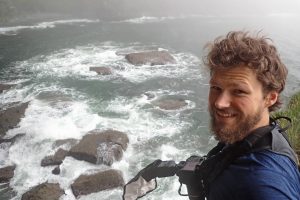
Nicholas Ens is a graduate student at the University of Victoria under Dr. John Dower and Dr. Stéphane Gauthier. His current work involves integrating remote signals from echosounders with direct net samples to better estimate the biomass and composition of pelagic organisms in the open ocean. Nic is experienced in the analysis of echosounder data and has done so in collaboration with Fisheries and Oceans Canada for several years, along with other projects for various agencies. He has also participated in many DFO surveys where he has processed fish, zooplankton, and acoustic data. For this expedition, Nic is particularly interested in how the distribution, abundance, and composition of communities of zooplankton and micronekton vary in the Gulf of Alaska, and how these organisms influence salmon feeding and distributions.
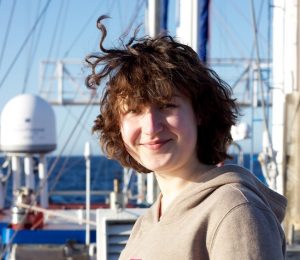 Marta Konik is a postdoctoral fellow at the Remote Sensing and Spectral Lab at the University of Victoria, Canada. She has a background in physical oceanography and remote sensing. She obtained her PhD at the Institute of Oceanology of the Polish Academy of Sciences in Sopot, Poland. During her PhD she worked on identification of cyanobacteria blooms in the Baltic Sea and phenology analyses of the blooms, based on multiyear satellite data series.
Marta Konik is a postdoctoral fellow at the Remote Sensing and Spectral Lab at the University of Victoria, Canada. She has a background in physical oceanography and remote sensing. She obtained her PhD at the Institute of Oceanology of the Polish Academy of Sciences in Sopot, Poland. During her PhD she worked on identification of cyanobacteria blooms in the Baltic Sea and phenology analyses of the blooms, based on multiyear satellite data series.
As a participant of the International Year of Salmon 2022 expedition she will collect samples for the pigment analyses that will be used to identify phytoplankton functional types, which are the primary producers in the Ocean, present in the sea waters during winter. She works on determining biological provinces of the North Pacific based on the differences in composition of phytoplankton, as it is an important part salmon food web and one of the factors affecting salmon survival. Satellite data will help her to understand complex relationships between environmental conditions, phytoplankton and zooplankton abundance, and salmon returns rate that could be used for future predictions.
 I am a postdoctoral researcher at the University of British Columbia working with Dr. Brian Hunt to investigate food web dynamics in zooplankton communities. This project uses fatty acids as dual indicators of trophic pathways and nutritional quality. We aim to understand how environmental conditions influence the fatty acid composition of microbial communities and how those dynamics in turn influence zooplankton. These processes are foundational to understanding the bottom-up effects of prey quality on salmon and other fish in the Salish Sea and along the British Columbia coast.
I am a postdoctoral researcher at the University of British Columbia working with Dr. Brian Hunt to investigate food web dynamics in zooplankton communities. This project uses fatty acids as dual indicators of trophic pathways and nutritional quality. We aim to understand how environmental conditions influence the fatty acid composition of microbial communities and how those dynamics in turn influence zooplankton. These processes are foundational to understanding the bottom-up effects of prey quality on salmon and other fish in the Salish Sea and along the British Columbia coast.
I grew up on San Juan Island and completed my PhD at the University of Washington with Dr. Julie Keister. My dissertation investigated the effects of ocean acidification on krill and copepods using a combination of field observations and laboratory experiments. It was during graduate school that I first had the opportunity to participate in a large systematic oceanographic cruise and I am excited to be a part of the IYS expedition because of how powerful they are for understanding an ecosystem from physical drivers up through the entire food web.
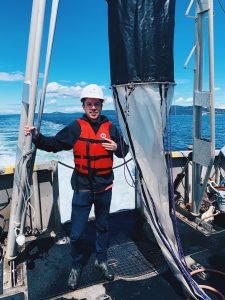 I am a Master’s student at the University of Victoria working under Dr. John Dower and co-supervised by Dr. Akash Sastri of the DFO. The main focus of my research is zooplankton ecology and physiology, but I really enjoy participating in research cruises such as this to polish my oceanography skills. My current work involves testing biochemical approaches of measuring zooplankton secondary production in situ. This information should bring to light techniques that are easier to execute than traditional methods of measuring secondary production, while still retaining accuracy. I am very excited to be a part of this expedition and see the distribution and
I am a Master’s student at the University of Victoria working under Dr. John Dower and co-supervised by Dr. Akash Sastri of the DFO. The main focus of my research is zooplankton ecology and physiology, but I really enjoy participating in research cruises such as this to polish my oceanography skills. My current work involves testing biochemical approaches of measuring zooplankton secondary production in situ. This information should bring to light techniques that are easier to execute than traditional methods of measuring secondary production, while still retaining accuracy. I am very excited to be a part of this expedition and see the distribution and
abundance of the zooplankton communities along Canada’s west coast.
Academic Partners
Read more about the exciting academic projects planned for the 2022 Expedition!
CCGS Sir John Franklin Survey Details
Departure from Victoria, BC – February 20, 2022
Transit to survey zone 5 and conduct first leg of integrated oceanographic and trawl survey – February 20 to March 7, 2022
Stop in Port Hardy halfway through for resupply and crew changer – March 8, 2022
Conduct second leg of integrated oceanographic and trawl survey – March 9 to March 20, 2022
Return to port in Victoria – March 23, 2022
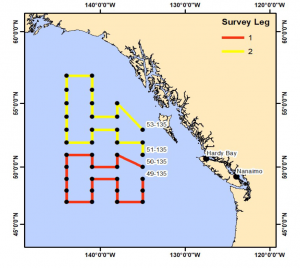
The Canadian research vessel the CCGS Sir John Franklin will leave its port in Nanaimo BC and carry out two survey legs out at sea, broken up by a stop in Port Hardy. It will conduct fishing, biological and oceanographic sampling throughout the entirety of its time at sea.
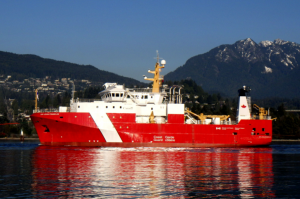
Name: CCGS Sir John Franklin
Gross Tonnage: 2,975
Length (m): 63.4
Maximum Speed: 12.5 knots
Year Launched: 2017
Home Port: Victoria BC
Flag: Canada
Scientific Equipment on Board
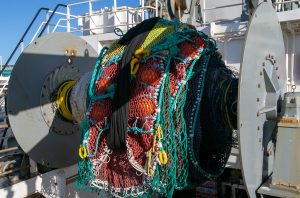 A large offshore midwater trawl net built by LFS in Bellingham, WA. A midwater trawl is a very large funnel-shaped fishing net. The front of a midwater trawl is generally constructed from large hexagonal or rhombic mesh or near-parallel ropes. Trawling involves the towing of net behind the fishing vessel. Large trawl doors that are essentially “kites” pull the net open sideways (50m) and the mouth of the net 50m is held open vertically by floats on the top and a weighted lead line on the bottom. The net is towed at 2.5-3 knots and the fish are swept back in the narrow end of the net called the codend. It takes consider able power to fly the net with the headrope at the surface to catch salmon that tend to live in the top 50m.
A large offshore midwater trawl net built by LFS in Bellingham, WA. A midwater trawl is a very large funnel-shaped fishing net. The front of a midwater trawl is generally constructed from large hexagonal or rhombic mesh or near-parallel ropes. Trawling involves the towing of net behind the fishing vessel. Large trawl doors that are essentially “kites” pull the net open sideways (50m) and the mouth of the net 50m is held open vertically by floats on the top and a weighted lead line on the bottom. The net is towed at 2.5-3 knots and the fish are swept back in the narrow end of the net called the codend. It takes consider able power to fly the net with the headrope at the surface to catch salmon that tend to live in the top 50m.
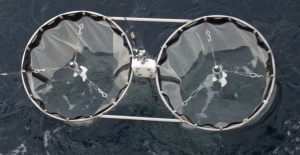 A bongo net consists of two plankton nets mounted next to each other. The nets have a long funnel shape with a small mesh width (0.2336mm) used for collecting plankton. The bongo net can be configured to be towed vertically (up and down) or horizontally towed at 1-2 knots with a weight attached between the nets.
A bongo net consists of two plankton nets mounted next to each other. The nets have a long funnel shape with a small mesh width (0.2336mm) used for collecting plankton. The bongo net can be configured to be towed vertically (up and down) or horizontally towed at 1-2 knots with a weight attached between the nets.
A split-beam echosounder is comprised of two aspects, as well as a transducer. The first aspect is a high-resolution color display for displaying echograms at certain observations, which also serves as a controller in the operation of the echo sounder. The second aspect is a transceiver which consist of a transmitter and receiver of acoustics.
 CTD stands for conductivity, temperature, and depth and the device’s function is to detect how conductivity and temperature of the water column changes relative to depth. Conductivity is a measure of how well a solution conducts electricity, and it is directly related to salinity, or the concentration of salt and inorganic compounds in seawater. CTDs are attached to a metal frame called a rosette, which holds water-sampling bottles that collects seawater at different depth. The information that is generated from CTD data can be used to calculate the speed and direction of ocean current as well as map the distribution of temperature and salinity throughout a survey area spatially as well as at depth.
CTD stands for conductivity, temperature, and depth and the device’s function is to detect how conductivity and temperature of the water column changes relative to depth. Conductivity is a measure of how well a solution conducts electricity, and it is directly related to salinity, or the concentration of salt and inorganic compounds in seawater. CTDs are attached to a metal frame called a rosette, which holds water-sampling bottles that collects seawater at different depth. The information that is generated from CTD data can be used to calculate the speed and direction of ocean current as well as map the distribution of temperature and salinity throughout a survey area spatially as well as at depth.
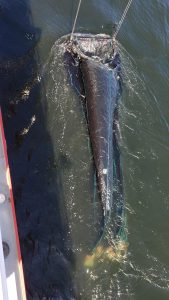 MOCNESS is an acronym that stands for Multiple Opening and Closing Nets and Environmental Sampling System. Basically, it is a set of nets stacked on top of each other in a single frame that can be towed behind a ship. Scientists can trigger each of these nets to open independently of each other. The MOCNESS delivers data in real time, which allows scientists to control exactly where the nets are and what they are sampling.
MOCNESS is an acronym that stands for Multiple Opening and Closing Nets and Environmental Sampling System. Basically, it is a set of nets stacked on top of each other in a single frame that can be towed behind a ship. Scientists can trigger each of these nets to open independently of each other. The MOCNESS delivers data in real time, which allows scientists to control exactly where the nets are and what they are sampling.

